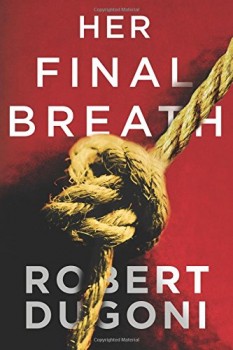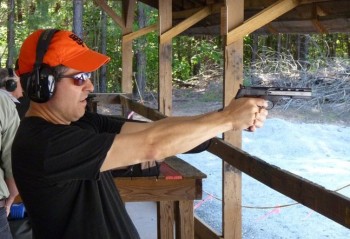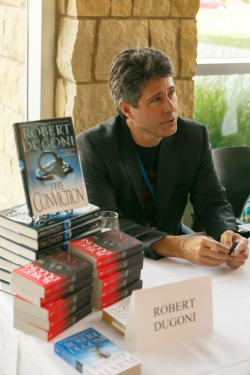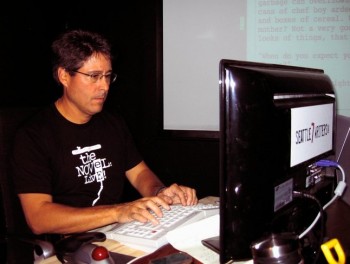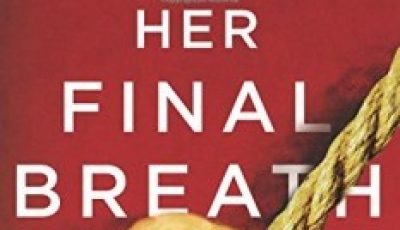

Between the Lines with Robert Dugoni on ‘Her Final Breath’
Insights From the Master of Seattle Menace
An acclaimed author of legal thrillers with his David Sloane series, Robert Dugoni decided to undertake a new challenge: a thriller featuring a woman, Seattle homicide detective Tracy Crosswhite. The result proved the adage “Change is good.” My Sister’s Grave became a No. 1 Amazon and New York Times best seller.
Tracy Crosswhite returns in Dugoni’s HER FINAL BREATH (Thomas & Mercer, September 15, 2015). Still scarred from the investigation into her sister’s 20-year-old murder, Crosswhite is drawn into an investigation of a string of homicides perpetrated by a serial killer known as The Cowboy. A stalker leaves a menacing message for Crosswhite, suggesting that the killer or a copycat could be targeting her personally. With clues scarce and more victims dying, Crosswhite realizes that the key to solving the murders may lie in a decade-old homicide investigation that others, including her boss, Captain Johnny Nolasco, would prefer to keep buried. The events that follow threaten to end Crosswhite’s career, and perhaps her life.
Robert Dugoni has served as an inspiration to aspiring writers as well as fledgling authors. His novels not only describe the conflict inherent in the legal system in a dramatic and understandable way but also portray complex characters unique to legal and crime fiction. His portrayal of the city of Seattle as setting—as almost another character in the story—is masterful.
I found HER FINAL BREATH just as compelling as My Sister’s Grave. What inspired you to move on from popular David Sloan and write this series?
Necessity is the mother of invention, and I needed a new series. I was leaving my publisher, and the David Sloane series was divided between two publishers. So I knew I had to do something original. It was daunting, but I’ve faced many challenges in my career and this one didn’t scare me. It was actually refreshing to be doing something new.
Tracy Crosswhite is a character I introduced briefly in the novel Murder One, a female homicide detective who was a former chemistry professor. Honestly, I had no idea who she was or where she came from, so I just started exploring her background more and more as I interviewed homicide detectives in Seattle and then a friend introduced me to single-action shooting competitions. She came to life. I knew she’d be perfect for a book needing a strong female protagonist, and I had an idea for a spin on an old legal adage that I thought would make a great twist. I don’t outline, but I also knew I wanted a wounded protagonist, someone who had lost someone very dear to them years before and from that came the relationship between Tracy and her sister, Sarah.
What led you to write HER FINAL BREATH?
In My Sister’s Grave I had a second story line in which Tracy was chasing a killer of young women. My editor, Alan Turkus, thought it was a great story line but that I would not be able to do it justice unless I made it a separate novel. He was right. The case is so personal to Tracy because she lost her sister; I knew I could develop the plot into a character-driven police procedural with a serial killer. Beyond all that, I live in the city that produced Ted Bundy and Gary Ridgway.
Please describe the transition from writing about a lawyer to writing about a police detective.
It takes a lot more research. As a lawyer, I know the day-to-day workings of a law firm and a courtroom. I’ve also sat in on several criminal matters and I can appreciate the nuances of the criminal justice system. Police procedure is whole new ground for me, and so I really have to rely on experts in their fields. Luckily, I’ve been very fortunate to have friends working in the criminal justice system who introduce me to experts like forensic anthropologists, trackers, homicide detectives, canine specialists, CSI detectives, scientists at the crime lab, and more. They are extremely gracious and generous with their time.
Are there constraints when depicting a woman protagonist that don’t exist when writing about a man?
Maybe 50 to 60 years ago, when the roles of men and women were so delineated, but I really don’t think so anymore. I think it’s been proven that women can do just about anything a man can do, and in some respects, they can do it a lot better. Women and men want the same things in life: security, respect, justice, a chance to succeed and make a decent living. There are nuances for certain. I know in my relationships with women in my life that we don’t always view things the same way, nor do we solve issues the same way. I tend to be more reactionary, quick to act. Women in my life tend to think things through longer and to seek multiple opinions before making decisions.
When writing thrillers, your protagonist, male or female, has to be heroic to some degree. She or he has to have some quality that readers can identify with, if not like. David Sloane was cerebral. He tended to outsmart the people he encountered. Tracy is actually a little quicker to act, with a shorter fuse. She’s smart, but she can also put a bullet between a bad guy’s eyes quicker than most can draw their gun.
Putting aside Crosswhite, who’s your favorite character in the novel?
I love detective Vic Fazzio, one of the four members of the Violent Crimes Section’s “A-team.” “Faz” is actually very close in physical characteristics and demeanor to a photographer I worked with 30 years ago at the Los Angeles Times. I can’t even remember his name, but he was truly a character. A genuinely good guy, very down to earth, funny, said the things we all wanted to say but wouldn’t, but who also wore his emotions on his sleeve and had a zest for Italian food and for life.
The novel is primarily set in the Seattle, Washington, area. What makes Seattle such an effective setting for a story about a homicide investigation?
I asked that question of a forensic anthropologist, and her answer was chilling. She said the reason we have so many serial killers is there are so many ways to dispose of a body. We have deserts. We have lakes. We have rivers, streams, bogs, marshes. We have mountains and forests. We also have weather that, because we are so far north, can change violently and quickly. We can have bright sunshine and then sudden severe rains. We get snow, sleet, hail, thunder and lightning, and high winds. All of that is wonderful for creating the mood in a good thriller.
In HER FINAL BREATH, the investigation into the homicides involves, among other things, DNA analysis, rope-fiber analysis, and the operation of “gentlemen’s clubs.” How did you research this novel?
Again, my acknowledgements are often very long because I rely on a lot of different experts. Any mistakes are usually when I don’t ask for help and think I know the answer. It’s no different from being a lawyer with a complex case and asking expert witnesses to guide you through the process. You learn to ask questions that both support your case and that hurt your case so you hope you’re prepared for anything. As for the gentlemen’s clubs, well they are big in the South and in Colorado, and in my younger days I ventured into a few for bachelor parties and the like. The thing I quickly came to learn was those places are like casinos in Las Vegas: They’re after your money, and a lot of it. The other thing I found was they are unbelievable places to people watch. You really get all different kinds in there, and people tend to drop their facades.
Which books and authors inspired you?
I was inspired at an early age by the classics. My mother used to hand me books to read when I was bored. At a young age I read The Count of Monte Cristo, The Old Man and the Sea, Of Mice and Men, The Red Badge of Courage, The Great Gatsby. That’s when I fell in love with stories and characters. As I got older and studied journalism, I read All the President’s Men and thought about how words can change an entire country when written with meaning. Later, I admired John Grisham’s and Scott Turow’s ability to tell stories, and I began to read thriller writers like John Lescroart and Stephen Hunter, Tess Gerritsen and Lisa Garner. The guy I enjoy the most, for sheer brilliant writing, is Stephen King–books like The Green Mile, which is the only book I’ll read while I’m writing a novel and I read it every day, The Shawshank Redemption, Joyland, and 11-22-63. His novels inspire me to try to get better.
As an attorney myself, I always wonder why so many lawyers become writers.
For one, being a lawyer is tough, especially if you litigate. It wears on you. You’re basically going to work every day to fight with people. There is also the inevitable frustration with judicial rulings, and there are those lawyers who are just arrogant and disagreeable. So the burnout factor can be very high. Beyond that, I think lawyers are trained to think of the “what if” question – which is essential for every good novelist. We ask, “What if the witness says this as opposed to that?” “What if I’m missing something obvious?” “What if this case has a twist I didn’t see coming?”
Then there is the lawyer’s love of a good story. Go out for a beer with a group of lawyers and every one of them will have a story about something that happened that day, or in their career, and you can see how much they love telling that story. My lawyer friends also tend to read a lot. I think it is an escape. So invariably many lawyers think they can turn one of their case profiles into a good novel.
Writing conferences are rife with advice for aspiring writers. What advice would you give to authors who’ve published several novels but who haven’t yet broken out?
The same advice Jim Rollins gave me many years ago in a bar at Thrillerfest. He said, “It takes time, Bob. It just takes time.” I didn’t understand it fully back then, but I do now. Jim was saying it takes product. You have to put out consistently high-quality books to build your audience and to have a chance that one of those books will break you out. Let me add here that if it weren’t for Thrillerfest and the support and guidance of so many break-out authors, I’m not sure I would be here. It is an organization of truly generous people.
I also think you have to think of plots that have high concepts. I don’t mean save the world concepts but more of the “So what?” concept. Ask, “So what if my protagonist fails?” If nothing really traumatic or heart breaking is the result, you need a stronger premise for your novel. You want a reader to get to the end and not be able to bear the thought that your protagonist might fail because it means so much to the protagonist to succeed. I get a lot of emails from readers who want to be sure that Tracy is going to be okay, that she is going to be able to finally find some light and joy in her life. With the sequel out this month, they can find out for themselves.
Tell us about your next projects.
The third in the Tracy Crosswhite series, A Clearing in the Woods, will be published May 2016 and I really love that novel. I think it has all the emotion that made My Sister’s Grave so successful. I have a standalone legal thriller coming out probably in December 2016 – The 7th Canon, featuring a young San Francisco attorney in the 1980s who works for an uncle with a very eclectic practice and who finds himself in the middle of a very deadly game. I’m excited about that novel and I’m excited to do more legal thrillers. In between, there’s a Tracy Crosswhite short story, Patrol.
- Jeffrey Archer - October 12, 2023
- David Bell - July 7, 2023
- Up Close: Daco Auffenorde - October 31, 2020

